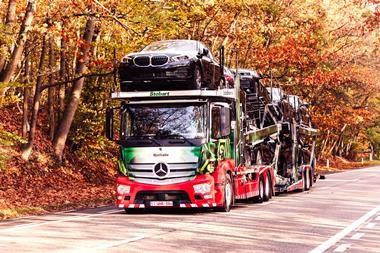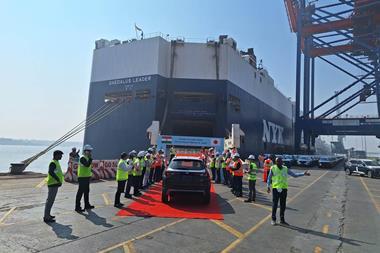Last year was a devastating one for European ports that depend on car handling. But while recovery is uncertain, Piotr Switalski uncovers the collaborative strategies towards which both ports and policymakers must work (Christopher Ludwig contributed reporting).
Last year was the first to statistically register the decline in vehicle traffic in European ports. On paper at least, 2008 will be seen as the end point of a strong run for car imports and exports, with Zeebrugge and Bremerhaven surpassing 2m vehicles for the second straight year. But figures from 29 ports showed a drop of 30% in total volume in 2009. Almost no ports saw increased volumes, with the exception of Italy’s Livorno and a modest increase for the port of Sheerness in the UK, both thanks to government incentives. The French ports of Le Havre and Marseille/Fos each saw import increases of 17% and 9%, respectively, thanks to the French programme, although exports tumbled.
Rotterdam was the biggest anomaly, growing more than a third. But according to Ton Van Ooijen, managing director for Broekman Automotive, which manages the terminal, the figures were inflated during the massively high stock period at the beginning of 2009, when Rotterdam accommodated thousands of vehicles that it normally wouldn’t handle (similarly, the port of Ghent saw a 50% rise in exports from such transhipment). “We had around 60,000 vehicles on our compound at that time,” Van Ooijen said. “We expect 2010 to be worse for Rotterdam.”
Vehicles flows fell dramatically for most, from a relatively resilient 10% drop in several British ports, a 19% decrease at the VW-dominated port of Emden, to more than 50% declines for Piraeus, Copenhagen/Malmö and Gioia Tauro. The biggest players, Zeebrugge and Bremerhaven, each fell 40%. Shipping lines, such as NYK, the largest ro-ro carrier, were particularly impacted by the decline in traffic from Japan. In 2009 Japanese exports to Europe, including Russia, were nearly 770,000 units, 42% down from 2008.
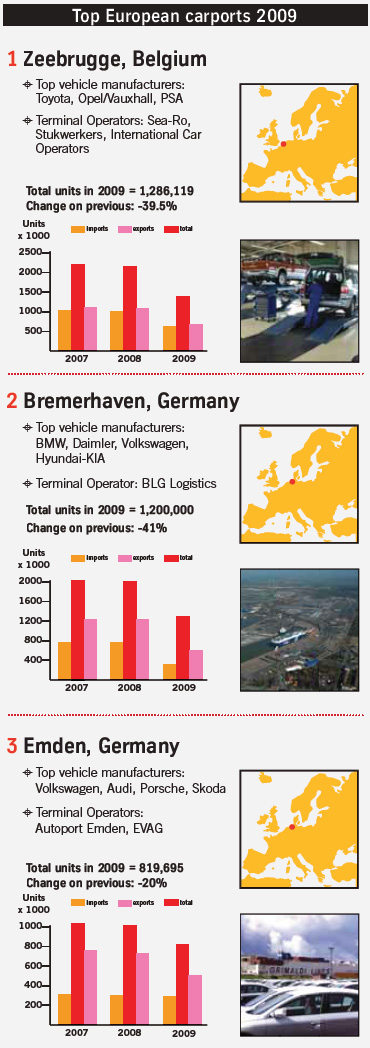
Although the numbers are more than a little gloomy, interviews nevertheless revealed a ‘we will survive’ attitude from all parties that commented. And discussions with some of Europe’s most important transport policymakers reveal the increasingly vital role that ports are likely to play in the EU.
Cut costs, cut jobs, what about quality?
Temporary labour was, in general, the main target for cost cutting in 2009. As Joerg Tuitjer, head of division automotive at EVAG explains: “We have a larger amount of cars going to the UK at the beginning of the year and again in July, August and September, so there are peak months where you have a lot of volume and, on the other hand, there are months in which there is comparatively little to do. This ebb and flow is resolved partially by outsourcing temporary staff during peak times.” Therefore permanent staff have been spared redundancies on a larger scale. Says Tuitjer, “In terms of shifts, we have not cut down on these year on year, but simply have not employed temporary staff. Naturally we have let them down and they have migrated towards other employment opportunities, but we have not cut down on our own fixed staff.” Looking further ahead past the current economic climate, Tuitjer acknowledges that this migration will be an issue once the markets pick up again and it will take time to get back an adequately trained workforce.
Together in strife?
The relationships between ports and shipping lines have been somewhat strained during the crisis. According to Peter Menzel, director and general manager of the car carrier group for “K” Line (Europe), most ports offered admirable cooperation and sacrifices to survive the downturn, with rate freezes and support to keep services at 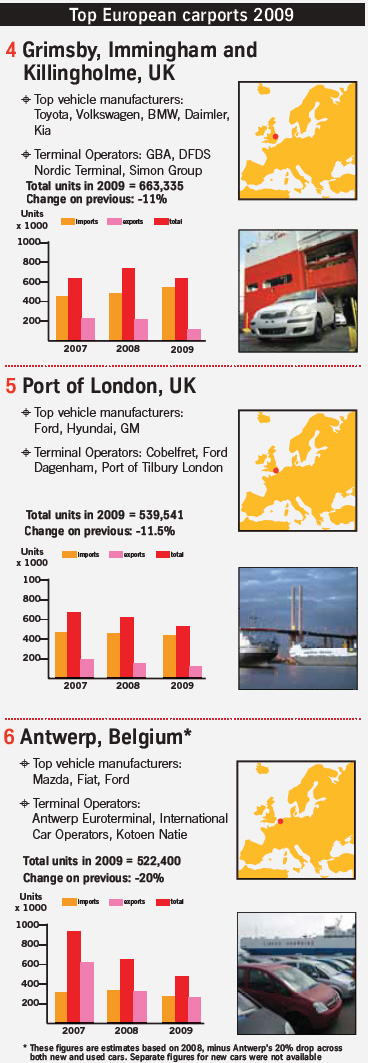 a good level. However, “there have been minor ports whose demands were quite unreasonable, but overall these were only few instances,” Menzel says. “For the most part the attitude has been that we are in the crisis together and should work together to get through it.”
a good level. However, “there have been minor ports whose demands were quite unreasonable, but overall these were only few instances,” Menzel says. “For the most part the attitude has been that we are in the crisis together and should work together to get through it.”
The port of Barcelona, for example, froze its port taxes for goods, vessels and passengers in 2009, and for 2010 has reduced them by 1%, according to Norma de la Fuente, a spokesperson for the port. There was a feeling, however, that the crisis has led OEMs to abandon partnerships, and to switch more readily between LSPs. Cooiman believes that in the long term this focus will not be a sustainable model. “One downside that is not mentioned too often is the fact that people lose sight of the value of long-term relationships and what comes with it, such as quality.” Cooiman also warns that sometimes companies see the purchase price rather than total cost. “The purchasing departments might be happy and proud with the new rates, but it might be that, as a result, there will be more accidents and worse customer service. If you focus too much on the price, then you might pay for it somewhere else,” he says.
The human factor as a long-term asset
One large problem for the ports and subsequently for their clients could continue to be with the training of staff to minimise quality issues while handling cars. At the port of Barcelona, the port has attempted to balance quality and cuts in part by employing an independent consultant to monitor the quality of handling at both its terminals since February 2009, according to de la Fuenta.
In general, however, mass redundancy, as with any industry, leads to a depletion of expertise. Dimitrios Theologitis, head of unit “Maritime Transport and Ports Policy, Maritime Security” at the European Commission (EC), stresses that “It is imperative to be able to go back to trained personnel capable of handling port equipment that nowadays can become extremely expensive and complex.” Partially as a result of the tensions between employees and employers during times of high pressure on jobs in the port domain, the EC is looking to develop social dialogue that would hopefully go toward assisting ports facing the risk of labour disputes and social unrest.
Theologitis admits that this dialogue has been promised for some time without action, but he is optimistic. He believes the process was initiated when the European political bodies, particularly the European Parliament, ‘narrowly’ rejected the two port services directives, which would have liberalised the European ports industry.
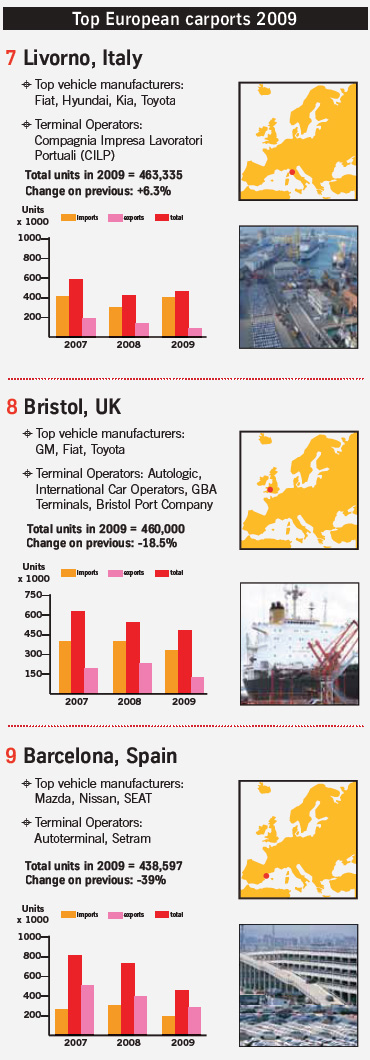 “We decided to take a different route,” he says. “The then commissioner for transport, Jaques Barrot, proposed the dialogue approach. We are embarking on a dialogue between employers and employees in order to make sure that the working climate in the ports is better accepted and that there is less social unrest.”
“We decided to take a different route,” he says. “The then commissioner for transport, Jaques Barrot, proposed the dialogue approach. We are embarking on a dialogue between employers and employees in order to make sure that the working climate in the ports is better accepted and that there is less social unrest.”
At the moment, however, the dialogue will be confined to matters of health and safety, training and qualifications, which are relevant especially in the context of seasonal workers. “We are optimistic that both employers and employees will find ways to start this dialogue and we expect developments in the next few months,” Theologitis adds. Besides the EC, the International Labour Organisation is expected to play a key role in this issue. And indeed, all the stakeholders in the vehicle logistics chain are looking at developments of the labour issue.
“As a company we are unhappy when there is a delay in a port of some kind, such as due to labour disputes.” says Svein Steimler, president of NYK Line (Europe) Ro-Ro. “Naturally, due to the current pressures, there are instances of quality or timeliness issues, but we continue to stay on top of these things. We continue to have meetings with ports to make sure we are top level when it comes to the various potential issues in relation to ports.”
This promises to be a topic of continuing development and uncertainty, particularly as European countries face tough cuts in public spending that could impact port operations further. The tension is already palpable, as even socialist governments are losing the support of their former allies–the labour unions–as is the case in Spain and Greece. As cuts come into force, dialogue is likely to become harder and harder.
The need for dialogue in difficult economic times is not only essential in the case of labour disputes, but also to the overall effort to increase a port’s competitiveness. Patrick Verhoeven, secretary general, European Sea Ports Organisation (ESPO), cites the port of Antwerp as a good example of how such dialogue can help avoid problems. “The port was losing a lot of market share in terms of conventional cargo due to the crisis. To get that cargo back they developed an action plan with the private sector stakeholders, with labour unions, to discuss together what they could do increase the competitiveness of the port.”
Tougher times must bring out the best
As described in previous reports, low volumes also present opportunities to review operations with the view toward improving the operations, including handling, IT or 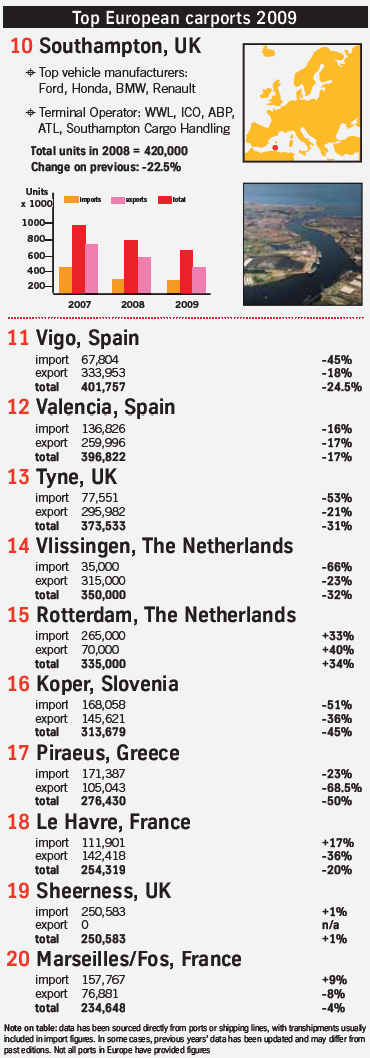 administration. This has been the expectation of BMW, according to Mathias Wellbrock, general manager vehicle distribution. “Creating even more efficient processes and saving costs are our objectives in optimising port use during the downturn. Especially in times of low volumes, we expect our partners to actively optimise their own processes and share the benefit with us. This includes processes that could not be analysed during times of peak volumes, such as pressure and capacity constraints.”
administration. This has been the expectation of BMW, according to Mathias Wellbrock, general manager vehicle distribution. “Creating even more efficient processes and saving costs are our objectives in optimising port use during the downturn. Especially in times of low volumes, we expect our partners to actively optimise their own processes and share the benefit with us. This includes processes that could not be analysed during times of peak volumes, such as pressure and capacity constraints.”
At the same time BMW is also open to adjust its processes if this would benefit all parties, according to Wellbrock. Another area of port operations that Wellbrock believes needs improvement is the administrative processes, particularly regarding customs and document handling. While on the one hand disparity in this area is partially the result of differences in individual port procedures or international trade regulations, OEMs and policymakers believe the industry should be working together to break down such barriers within the borders of the European Union. Theologitis says: “Maritime transport should not have barriers which would hinder it from fulfilling its goals and potentials. We are quite envious of road transport, where Europe has done miracles to drop down barriers and borders between countries in the EU. What we are doing right now is working on the same concept in maritime transport. It is difficult to understand that a truck can criss-cross all of Europe without any controls, except for the random checks, yet at the moment when the same cargo is put on a ship, and the ship sails, the cargo is considered to be international.”
The reason for this designation is that once a ship leaves the 12-mile costal zone it technically moves into international waters, and as it returns inside this zone the goods are considered ‘exported’. Also, the mix of origins and final destinations for the various cargos aboard a ship makes the customs procedures even trickier. Theologitis asserts that the EC is trying to “to bring another layer of facilitation” to aid this, or in another words, that the goal should be that direct connections between two European ports are considered intra-European movement and not international. The EC has identified an action plan to address these barriers. The subjects covered include customs controls, sanitary controls, communications between business and administration, as well as between ship and shore–the so-called ‘e-maritime’ concept, an initiative to further the use of advanced communication technologies for working and doing business in the maritime sectors.
There has already been some success, according to Theologitis, including a reduction in customs controls for ships carrying community goods, or connecting directly from one EU member state port to another. There have also been proposals for a change in reporting formalities for ships that would insist upon electronic communication between ship and shore, hopefully creating a lower burden for businesses in their contacts with administrations. This proposal has been made last year and Theologitis is hopeful to have it adopted as early as before this summer.
Co-modality–friend or foe?
Seaports are by their nature dependent on links and transport connections with the hinterland. For example, de la Fuente, at the port of Barcelona, stresses that better hinterland connections, particularly for rail, would make the port more competitive for carmakers. “Our aim is to gain new customers in inland areas, such as Madrid, Zaragoza and France,” she said. “Reliable and competitive railway connections with these kind of destinations are crucial to achieve this goal.” At the same time these lifelines to the ports are often the modes of transport directly competing with them, especially in the context of short-sea shipping.
“In terms of the connectivity with the hinterland, we are currently embarking upon the revision of the guidelines for the trans-European networks,” says Verhoeven. These should identify the so-called ‘core network’, which will be a multimodal network. There is also the development of the ‘comprehensive network’ that will take care of the regional connections. There will also be a conceptual layer, which will encompass such items as the development of intelligent transport systems for all modes, including maritime.
Verhoeven believes that every mode of transport has its own role to play. “The concept of co-modality as far as we understand has to get the best out of every mode,” he says. “It would be delusional to think that any mode could be taken away entirely. It is also important not to have a forced movement towards one or another mode, for example, focusing exclusively on rail or barge transport and penalising road transport. What we can do is to ensure that for longer distances rail and barge use their full potential, and to work with terminal operators to that effect.”
Theologitis stresses that the Commission is trying to make sure that all modes of transport start from the same assumptions. These include the liberalisation of transport, whether road, rail, ship or air; secondly that there is interoperability, meaning that basic technical requirements are the same; and finally that the EU can give opportunities for entry into the market for all operators that prove that they fulfil certain criteria.
However, as Theologitis explains, sometimes the conditions of use are not equal. For example, the external costs of using transport are different, as the various modes still do not have the same conditions. “We are trying to make sure that there is [equal] participation in infrastructure or environmental costs, for example. But this particular initiative is not finished yet. For that reason, we are trying to see how we can combine the modes best to achieve certain policy goals.” These policy goals are also environmental, as seaports have the potential to play a tremendous role in reducing emissions. “In doing that [policy] can decongest the roads, and contribute to a better quality of life for the European citizen,” adds Theologitis.
Is Henry Ford’s vision wrapped in red tape?
Henry Ford envisaged that his factories should be located near water-based transport routes, be it barges or ships, in recognition of the economic and volume potentials of this mode. Also, the majority of potential consumers of the Model T lived close to waterways. In this way, the concept of the ‘Motorways of the Seas’ began at the birth of the motorcar and how it should reach the customer. This concept has been discussed among various stakeholders, yet there are different approaches on the issue.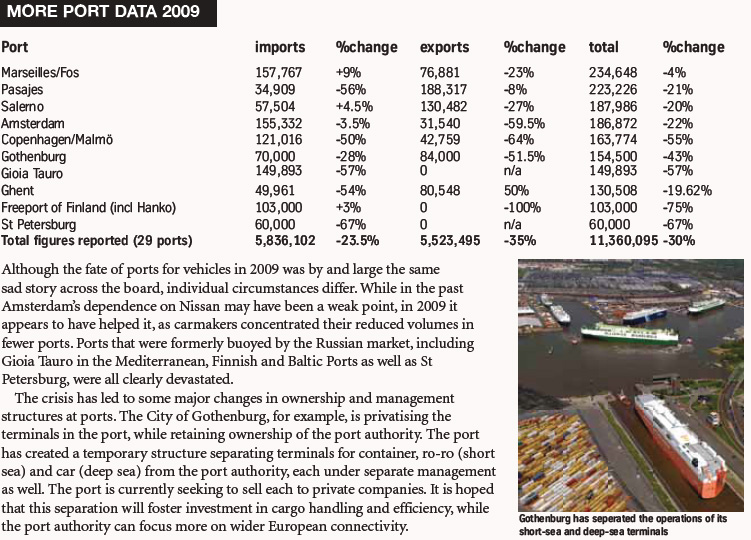
The concept is now being discussed at the EC during the revision of the trans-European network guidelines. Theologitis admits that there has been some confusion over what encompasses a ‘motorway of the sea’. As the current EC discussion is still ongoing, he is unable to give final conclusions before the official guidelines will be published in 2011. But he suggests a basic approach. Just as there is a network of roads crisscrossing a country, with some called motorways because of their allowed speed and characteristics, there could be the same understanding at sea. “We have hundreds of maritime connections across Europe. To realise the trans-European network, some of them need to have certain characteristics of service, such as frequency, capacity, speed and quality in general.”
ESPO, which represents port interests to EU bodies, has some doubts, however, about the EC’s method on this subject. “In theory Motorways of the Sea is a good concept, but in practice there are still difficulties involved, in the sense of potential distortion of competition” warns Verhoeven. “If you pick out certain routes and ports and put public investments behind them, you risk undermining existing shipping lines and ports which are doing a good job already.”
According to Verhoeven, there is scepticism within the ports sector and the shipping industry about this concept, particularly the influence that member states might have on choosing which ports should be privileged with funding. “You can imagine what it can do to the competitive landscape, so overall we have mixed feelings about the current implementation and we think it is necessary for a fundamental review of this proposal about whether it is within the spirit of true co-modality,” says Verhoeven. “The practical implementation and the consequences [of the policy] are often quite serious.”
Instead, Verhoeven proposes that the EC and the industry take a closer look at what connetions already exist and where the current bottlenecks are. “It should be a bottleneck-solving solution, rather than creating connections out of the blue. We know that there are already a number of very efficient lines operating, but maybe the problems are more in the port area and the connection to the land-based transport modes. The opportunity is there now, because the EC is going to review the trans-European transport network, of which the Motorways of the Sea is a part”.
Collaborate so as to compete better
Rather than waiting for bureaucratic processes to come into place, some ports prefer to act proactively and jointly. The Spanish ports of Vigo and Algeciras, as well as the French ports of Nantes and Le Havre, already take part in a Motorway of the Seas project that will connect Europe with the African port of Tanger, near to where Renault is building a plant. “That’s why the port of Vigo is interested in promoting its ro-ro terminal and shipping line advantages to potential final customers, such as another automotive manufacturer,” says Dolores Rois Orza, commercial manager at the port authority of Vigo.
Other Motorways of the Sea projects are also planned for Vigo: “One of our goals is to be able to cooperate with the shipping lines to start and develop the Atlantic Motorway of the Sea, promoting this useful alternative option through the regional transport road market,” Orza says.
Although the EC and ESPO might disagree somewhat on the approach to ‘constructing’ the Motorways of the Sea, in other fields the dialogue is bearing fruit in the form of common projects between EU institutions and its port stakeholders. The initiative to develop performance indicators as a tool for benchmarking is called PPRISM (Port Performance Indicators Selection and Measurement). It is sponsored by the EC, coordinated by ESPO and involves five research institutes. Verhoeven hopes the project leads to a kind of European port observatory.”
ESPO plans to consult with a range of stakeholders that are using European ports, including vehicle logistics providers, carmakers, rail and road transport providers.
2010 and beyond
As recovery in the internal European markets remains uncertain, ports are looking toward growth in the East. Despite recent declines in vehicle sales, markets such as Russia or Turkey are not yet saturated with competition and routes are still being developed. NYK’s Steimler states: “St Petersburg is not significant at the moment, but is going to become more important. The Black Sea is currently not too suitable for deep sea ships, but I am pretty sure Russia will develop more and more their own ports, as they look to import cars directly into their market.”
K-Line’s Menzel agrees that, in the past, Ukrainian ports were not a viable entry to the Russian market, in part because of the tensions between the two countries as well as the lack of suitable ports in the Black Sea (although tensions may ease following the recent elections of a pro-Russian president, Viktor Yanukovych). “In terms of Russia we feel that the market is bouncing back already. The Russian market cannot be satisfied with only a few models, as is the case in China or Latin America sometimes, so the imports from outside the Federation’s borders will continue to recover. Since the Russian economy largely depends on oil prices, as long as the price stays at $70-$80 a barrel, the Russian economy is in a good position to recover,” says Menzel.
Russian recovery, which is far from certain in the latest sales figures, will be essential to growth in several ports that send vehicles there via transhipment, particularly Bremerhaven, Copenhagen/Malmö and the Freeport of Finland, as well as ports in the Baltic countries. According to Elena Zhadanova, from the RTL Group, which manages the largest terminal in St Petersburg and is also a Customs broker, imports to its terminal fell from 180,657 in 2008 to just 60,000 cars last year. RTL does not expect a return to previous levels anytime soon. With Russia an unknown, ports such as Amsterdam, Zeebrugge, Bremerhaven and others are also keen to get a leg up on Chinese and Indian-built cars that will eventually be imported to Europe. Although in someways that trend is reversing, at least for Western Europe–particularly from China, as Honda shifts production of the Jazz from China to the UK–there is little doubt in the minds of most terminal operators that flows from these countries will be important in the medium to long term. According to Saverio Failli, from the port of Livorno, the Autotrade and Logistics group at the port has signed a new contract to import and distribute cars made in China. The first cars should arrive in October, with intial annual traffic estimated at 8,000-10,000 cars, eventually reaching 20,000-40,000.
To some extent, there is little that ports can do to influence the main support line of their business. Carports grow and falter together with their automotive clients in corresponding markets, and thus 2009 saw relative strength for locations that benefited from scrappage incentives. Valencia benefited from Ford production exported to markets like Germany, while Barcelona saw increases of 15% in November and December, and a 185% increase in January, as incentives in Spain helped recovery. UK ports also saw a late-year rise in imports following its own incentives, particularly for imports from Germany, Italy and Korea.
But beyond the market’s whims, it is clear that those organisations that are flexible, innovative, proactive and collaborative with relevant stakeholders can look with some added optimism into the future. That may be the only silver lining in sight around Europe’s clouded coastal fronts right now. However, the importance that these gateways will play in both recovery and future transport development in Europe appears to be among the few guaranteed increases the continent can talk about today.





















